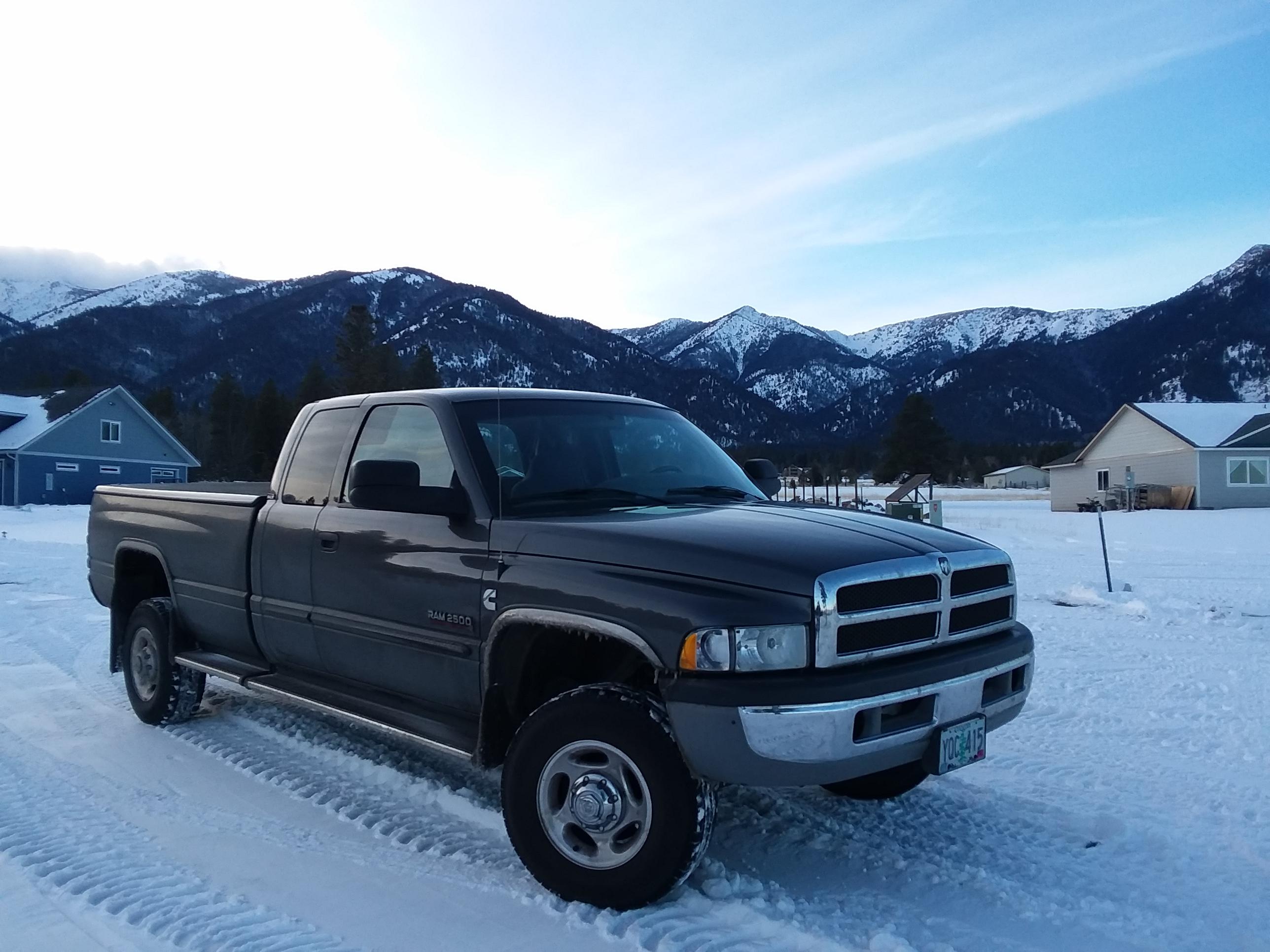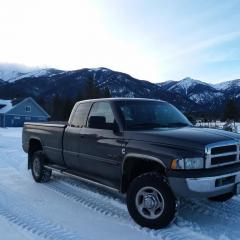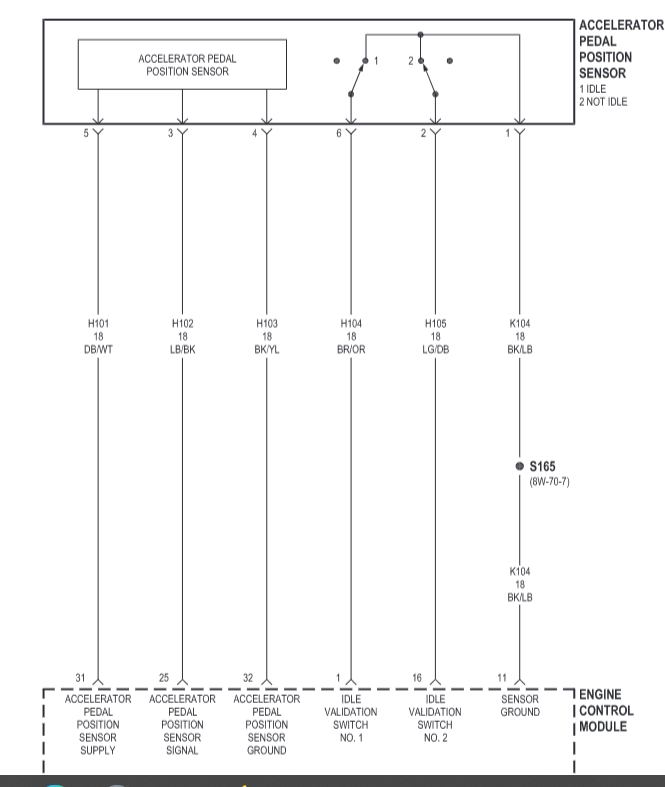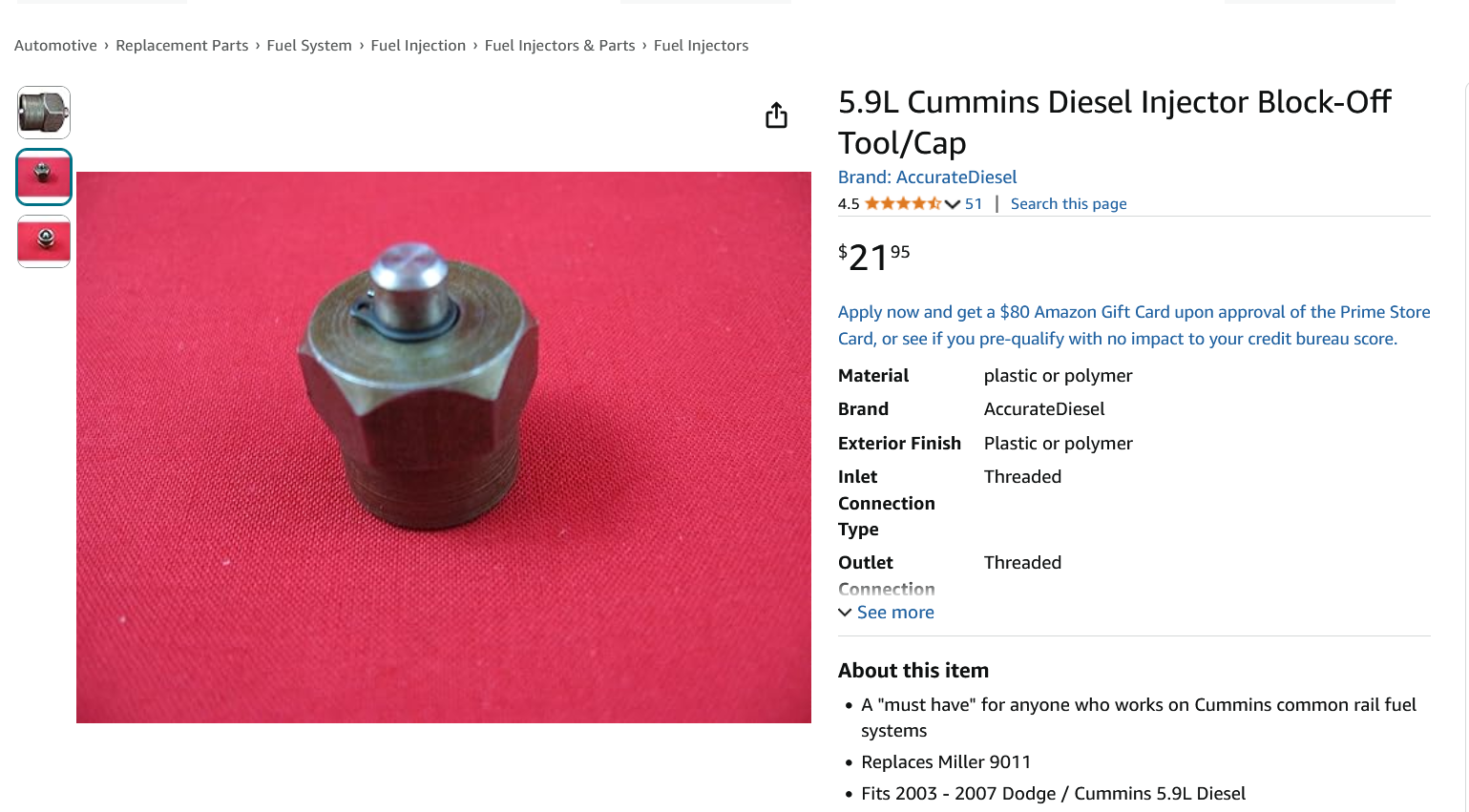
Everything posted by Tractorman
-
Another APPS Problem
200 or 500 volts, or 200 or 500 millivolts? Your test results: 35 volts or 35 millivolts (.035 volts)? Need to be clear on this. - John
-
Another APPS Problem
I don't know the voltages of each wire, but there are two ground connections that can be checked with an ohmmeter. Both are grounded through the ECM (pins #11 and #32 on the ECM). I would do the W-T wiring mod first, then start with diagnosing the APPS, if the symptoms aren't corrected. - John
-
Another APPS Problem
Since the ECM is the only component that communicates with the APPS, it would be a good idea to re-check connections for resistance and make sure the ECM has a good positive and negative connections. You will be addressing the ECM ground with the W-T ground reference modification. - John
-
Another APPS Problem
Do you have any DTC's set, especially related to the APPS? If you don't, I don't think the APPS is causing the problem. You might try another scan tool just confirm the same readings. Does the engine idle at the correct rpm? I think I would start by checking all battery connections and grounds to make sure there are no issues there. I would also completely disconnect the Edge tuner and put the Smarty back to stock while troubleshooting just to eliminate potential issues. - John
-
2006 Dodge Ram 3500 - Thor Project
The above post indicates that fuel rail pressure rises quickly to well above 4,500 psi, but the engine continues to crank a long time before starting. This post indicates that fuel rail pressure stays well below 4,500 psi during cranking and the engine won't start until the pressure suddenly jumps above 4,500 psi. Which post is correct? - John
-
2006 Dodge Ram 3500 - Thor Project
So, at this point it doesn't sound like you are seeing anything that would be contributing to the symptoms you are having - is that correct? Bummer about the broken injector. - John
-
2006 Dodge Ram 3500 - Thor Project
Whadda ya doin'? - John
-
Replace or Rebuild?
The rust issue would encourage me to replace. I have similar miles (394,000), but no rust, so I continue to invest in mine. - John
-
2006 Dodge Ram 3500 - Thor Project
Interesting - not what I was expecting. I was expecting to see rail pressure below 4500 psi while cranking during the hard start. That would have made sense as the ECM would not have turned on the injectors at that low of pressure. Also, it would have coincided with high fuel return rate. So, if I am understanding correctly, you are getting fuel rail pressure above 4500 psi immediately, even with the FCA connected and the engine still won't start. So, the question for me is, why isn't the ECM telling the injectors to fire right away? This is where my lack of fully understanding the details of how a common rail fuel system works comes into play. If this were my truck, I think I would want to know what all has to be in place before the ECM will tell the injectors to fire. Example: could an engine rpm sensor cause the ECM to not fire injectors, or could the fuel pressure sensor cause the ECM not to fire injectors?, etc. - John
-
2006 Dodge Ram 3500 - Thor Project
I would still be interested in the behavior of the fuel rail pressure while the engine is cranking during a hard start. I don't think you have done that, yet. If the fuel rail pressure is low during the hard start, remove the fuel control actuator electrical connector and see if the rail pressure rises when cranking the engine and the engine starts right away. If it does, you have a high return flow rate problem somewhere - not an "air in the fuel" problem. - John
-
Help! No Power Steering or Brakes after vacuum pump swap
You can remove the flow control / pressure relief valve cartridge without removing the power steering pump. - John
-
Help! No Power Steering or Brakes after vacuum pump swap
@RayNAz, did you skip this step while you had the unit on the bench? - John
-
2006 Dodge Ram 3500 - Thor Project
It sounds like you are on the right path. - John
-
2006 Dodge Ram 3500 - Thor Project
What is the rail pressure while cranking during a hard start? - John
-
2006 Dodge Ram 3500 - Thor Project
I would be more interested in observing rail pressure during the long cranking periods, not when the engine is idling. If the rail pressure is well below 4,500 psi during long cranking, then you know that you have fuel bleeding off somewhere. If it stays around 4,500 psi or higher during the long cranking period, then you know something else is going on. Either way, it offers information. As far as the chimes, are the "grid heater light" and the "wait to start light" the same item on a 2006 common rail truck? Here is what I am finding: WTS and 5 chimes - "The WTS light and chimes are a leak detection DTC, which means that the fuel calculation between the used versus demanded is out of range.." - John
-
2006 Dodge Ram 3500 - Thor Project
My knowledge is fairly limited regarding the 3rd generation trucks. If you don't already have these tools, a couple of tools I recommend would be a scanner that can read commanded rail pressure and actual rail pressure, and an injector block off tool. I have used them in the past and they have helped me diagnose a faulty injector. I know that when the engine is cranking, if the fuel rail pressure is below 4,500 psi, the ECM will not command injectors to fire. - John
-
ECM bad?
My next step would be to inspect the pin connectors on the Smarty cable and the pin connectors in diagnostic connector under the dash, if you haven't done so already. If everything seems good there, then you might try contacting Smarty for help before you condemn the ECM. - John
-
ECM bad?
Have you tried "Recovery of the ECM" (page 9 of the Smarty S03 Instruction Manual)? This may fix your issue. - John
-
Help! No Power Steering or Brakes after vacuum pump swap
I don't see any benefit using the clear tubing. Once the engine has been run, there are literally thousands of tiny air bubbles in the system. The air bubbles will dissolve faster as the fluid warms or slowly each time the engine is turned off, but they will work themselves out. You are worrying too much about things that are not important. So, back to the drawing board. Are you saying that when the front axle is on jack stands and engine is running that there is no power steering assist at all? and no brake assist at all? Are you keeping the reservoir constantly topped off when you are doing this test or other tests? Try to think this through before you make your next move, so that your next move will count. We are here to help (or hinder) you. Also, to answer a question that I forgot to answer..., on my truck, the return line from the brake booster is closest to the engine block when the pump is mounted. I don't think it would matter for the problem you are having, but by design there could be better mixing of fluid in one return port vs. the other. - John
-
Help! No Power Steering or Brakes after vacuum pump swap
I think it will be good for you to take a break from this - should help to clear your mind. In the mean time I will attempt to offer an explanation of how the power steering / brake hydroboost system works. The power steering pump and its integrated flow control / relief valve are fastened to the reservoir. The power steering pump is a fixed displacement vane pump. The flow control valve portion of the integrated flow control / relief valve ensures that there is always about 3 gpm of power steering fluid flowing, regardless of engine rpm. This steady flow of fluid gives the steering a good feel under all operating conditions. The relief valve portion of the flow control / relief valve is set at about 1450 psi (not the 4500 psi previously mentioned). Its purpose is to set a maximum pressure to allow work to be done and to also protect the pump and other components within the system. Since pressure is directly related to resistance to flow, the pressure in the system will always vary and will only reflect the work being done by steering or brake applications at any given moment. Most of the time the power steering pump is operating at a pressure far, far lower than the power steering relief valve setting. Power steering fluid leaves the pump at 3 gpm and passes through the brake booster control valve at 3 gpm and then passes through the steering gearbox control valve at 3 gpm and finally arrives at the reservoir at 3 gpm. There is always 3 gpm of power steering fluid flowing through the system regardless of engine rpm and regardless of what components are being operated. The ONLY time fluid flow will be stopped is if the pressure of the fluid is forced to rise above 1450 psi - then the fluid will return directly to the reservoir via the internal relief valve. So, actually the pump will still be providing 3 gpm of flow, but the flow will be returned immediately to the reservoir. The brake booster has a small nitrogen pre-charged accumulator that holds a charge of hydraulic fluid in reserve to provide a couple of brake applications in case of power steering pump failure. The brake booster has a priority control valve to hydraulically charge this accumulator immediately with power steering fluid on engine startup - probably less than one second to charge. The brake booster also has a control valve that uses some of the power steering flow to assist with brake applications. As far as a description of the hoses, there are two high pressure supply hoses in the system. One high pressure hose leaves the pump and connects to the brake booster, the other high pressure hose leaves the brake booster and connects to the steering gear box. There are two low pressure return hoses in the system. One hose leaves the brake booster and returns fluid to the reservoir, the other hose leaves the steering gearbox and returns fluid to the reservoir. The brake booster return hose will flow very little fluid - some from calibrated valve internal leakage and the occasional spurt from the release of the brake pedal. The steering gearbox return hose will always be flowing 3 gpm. The main reason there is much mystery regarding getting the air out of the system when replacing power steering components is that the small amount of fluid in the system gets recycled very quickly. The power steering pump is flowing 3 gpm and there is only about 1/2 gallon of fluid in the system. So, that means that the fluid leaving the reservoir is being returned to the reservoir in about 10 seconds. Any large globs of air do not have enough time to get removed to the surface while in the reservoir if the engine is running. This is why placing the front axle on jack stands and manually turning the steering wheel slowly from stop to stop without the engine running is the recommended practice. Do you mean "out of the pump" or "out of the reservoir"? Is the fluid being forced out around the cap? Is the cap installed? Aggressive turning of the steering wheel will make the flow pulse because the abrupt additional displacement of fluid from the cylinder in the steering gearbox will be added to the flow. So, what you are seeing could be normal. Hope this helps. - John
-
Help! No Power Steering or Brakes after vacuum pump swap
Been thinking..., Get the unit back out onto the bench (I know - you will really be looking forward to that) Remove the power steering pump. Using a depth caliper, confirm that the couplers are engaging properly. If all seems well with the measurements, then I would try this since the jaw coupling hub is pressed onto the vacuum pump shaft : Place the vacuum pump unit in a vise. Make a suitable tool that can be operated with a wrench to engage into the jaw coupling hub. Have helper hold the gear from rotating with the use of a strap wrench. Using the newly made tool and the wrench, try to rotate the coupler in the opposite direction of normal rotation to see if it slips. Use your best judgement on how much force to apply. If it slips, you have your answer. - John
-
Help! No Power Steering or Brakes after vacuum pump swap
Couplings can fail completely, or partially. If there is only a small load on the pump, a failed coupling could easily drive the pump, but the moment a larger load is applied, the coupling could begin to slip. I am not saying that this is the problem, but it can't be overlooked, especially since you mentioned at one point the you may have not had the pump fully seated during your first repair. Again, back to your first post, I am looking for you to confirm that no power steering fluid was lost during your first separation of the power steering pump from the vacuum pump. If no power steering fluid was lost, then the power steering pump would operate normally as soon as the engine was started. No bleeding of the system would have been necessary. Example of detail that I am looking for: "I removed the hoses from the pump / reservoir during the repair and lost power steering fluid" or, "I did not remove any hoses from the pump / reservoir during the repair and I did not lose any power steering fluid". - John
-
Help! No Power Steering or Brakes after vacuum pump swap
@RayNAz, thanks for providing more detail. I still need some clarification of the initial replacement of the vacuum pump. I am interpreting this to mean that the power steering pump and hydraulic system fluid were undisturbed during the replacement of the vacuum pump. Is this correct? If it is correct, then the power steering and power brakes should have been operational immediately upon startup. The fact that they didn't operate on startup indicates there is a problem with the coupling. If you did something different during the repair, please let me know. - John
-
Help! No Power Steering or Brakes after vacuum pump swap
Can you explain with more detail. It is possible that the coupler has been damaged if the pump was operated without the pump being fully seated. Also, just curious, what was the failure of the vacuum pump? Other than a leaking shaft seal, they are fairly bulletproof. - John
-
Is my grid heater dying?
The battery referenced in the diagram is the driver side battery. Let us know what you find. - John








